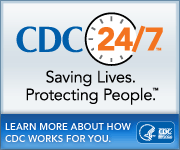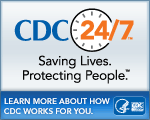Topics at a Glance

 There is a natural curiosity about CDC. Health professionals and the public want to be kept abreast of the latest scientific findings and health recommendations. Then there are others who want to know why CDC is mentioned in so many television shows and movies. As the nation’s premier health and research agency, CDC strives to improve the health of the public in every stage of life. CDC collaborates with partners to create the expertise, information, and tools that people and communities need to protect their health – through saving lives, protecting people, and saving money through prevention. Learn more about the many programs and projects that CDC is involved in, visit http://www.cdc.gov/24-7/.
There is a natural curiosity about CDC. Health professionals and the public want to be kept abreast of the latest scientific findings and health recommendations. Then there are others who want to know why CDC is mentioned in so many television shows and movies. As the nation’s premier health and research agency, CDC strives to improve the health of the public in every stage of life. CDC collaborates with partners to create the expertise, information, and tools that people and communities need to protect their health – through saving lives, protecting people, and saving money through prevention. Learn more about the many programs and projects that CDC is involved in, visit http://www.cdc.gov/24-7/.
Million Hearts®
 Million Hearts® is a national initiative to prevent 1 million heart attacks and strokes by 2017. It aligns existing efforts, as well as creates new programs, to improve health across communities and help Americans live longer, more productive lives. This will be accomplished through empowering Americans to make healthy choices and improving care for people who do need treatment by encouraging a targeted focus on the “ABCS”—Aspirin for people at risk, Blood pressure control, Cholesterol management and Smoking cessation.
Million Hearts® is a national initiative to prevent 1 million heart attacks and strokes by 2017. It aligns existing efforts, as well as creates new programs, to improve health across communities and help Americans live longer, more productive lives. This will be accomplished through empowering Americans to make healthy choices and improving care for people who do need treatment by encouraging a targeted focus on the “ABCS”—Aspirin for people at risk, Blood pressure control, Cholesterol management and Smoking cessation.
More information on Million Hearts, visit http://millionhearts.hhs.gov/.
Where are we today with HIV/AIDS in the United States?

CDC estimates that about 1 million people in the United States are living with HIV or AIDS. About 25% of these people do not know that they are infected and not knowing puts them and others at risk.
As a part of its overall public health mission, CDC provides leadership in helping control the HIV/AIDS epidemic by working with community, state, national, and international partners in surveillance, research, and prevention and evaluation activities.
Listen as speakers discuss the latest information and technology on prevention, transmission, and living with the HIV/AIDS virus. Visit the National Center for HIV/AIDS, Viral Hepatitis, STD, and TB Prevention for more information.
What are the economic impacts of an obese society?
 During the past 20 years, there has been a dramatic increase in obesity in the United States and rates remain high. In 2010, no state had a prevalence of obesity less than 20%. More than one third of U.S. adults, which is more than 72 million people and 16% of U.S. children, are obese. Since 1980, obesity rates for adults have doubled and rates for children have tripled. Obesity rates among all groups in society—irrespective of age, sex, race, ethnicity, socioeconomic status, education level, or geographic region—have increased markedly. Health concerns related to obesity-Type 2 diabetes, high blood pressure, stroke, gallbladder disease, and many others-can have significant economic impacts on a society. Speakers illustrate how innovative efforts, on behalf of CDC, have contributed to outreach, education and the leveling of obesity in the United States. Learn more about obesity
During the past 20 years, there has been a dramatic increase in obesity in the United States and rates remain high. In 2010, no state had a prevalence of obesity less than 20%. More than one third of U.S. adults, which is more than 72 million people and 16% of U.S. children, are obese. Since 1980, obesity rates for adults have doubled and rates for children have tripled. Obesity rates among all groups in society—irrespective of age, sex, race, ethnicity, socioeconomic status, education level, or geographic region—have increased markedly. Health concerns related to obesity-Type 2 diabetes, high blood pressure, stroke, gallbladder disease, and many others-can have significant economic impacts on a society. Speakers illustrate how innovative efforts, on behalf of CDC, have contributed to outreach, education and the leveling of obesity in the United States. Learn more about obesity
Should I be concerned about Diabetes?
 Diabetes is the 6th leading cause of death in the United States. It can cause serious health complications including heart disease, blindness, kidney failure, and even lower-extremity amputations. As of 2007, 23.6 million people—7.8% of the population—have diabetes and 1.6 million new cases of diabetes was diagnosed in people aged 20 years or older. Although not contagious, there are certain factors that can increase the risk of developing diabetes. Learn what those risks are and more as presenters provide the latest information on the different types and prevention of diabetes, and living healthy with the disease. Visit CDC’s Diabetes Public Health Resource for more information.
Diabetes is the 6th leading cause of death in the United States. It can cause serious health complications including heart disease, blindness, kidney failure, and even lower-extremity amputations. As of 2007, 23.6 million people—7.8% of the population—have diabetes and 1.6 million new cases of diabetes was diagnosed in people aged 20 years or older. Although not contagious, there are certain factors that can increase the risk of developing diabetes. Learn what those risks are and more as presenters provide the latest information on the different types and prevention of diabetes, and living healthy with the disease. Visit CDC’s Diabetes Public Health Resource for more information.
Are vaccines necessary?
 The top reason most people choose vaccination is to protect their children and themselves from potentially serious, even life-threatening diseases. There are other benefits, too. For example, widespread vaccination decreases disease, providing some protection for others in the community, such as infants who are too young to be fully vaccinated. Vaccines are safe and effective, and they remain necessary. Although many vaccine-preventable diseases are rare in the U.S., they still circulate here and around the world, so the threat of disease remains. The threat increases if vaccination rates fall. Listen as CDC scientists explain how and why vaccinations save lives and visit the National Center for Immunization and Respiratory Diseases (NCIRD).
The top reason most people choose vaccination is to protect their children and themselves from potentially serious, even life-threatening diseases. There are other benefits, too. For example, widespread vaccination decreases disease, providing some protection for others in the community, such as infants who are too young to be fully vaccinated. Vaccines are safe and effective, and they remain necessary. Although many vaccine-preventable diseases are rare in the U.S., they still circulate here and around the world, so the threat of disease remains. The threat increases if vaccination rates fall. Listen as CDC scientists explain how and why vaccinations save lives and visit the National Center for Immunization and Respiratory Diseases (NCIRD).
Is the threat of a Pandemic Influenza real?
 Yes. In the event of an influenza outbreak a pandemic will migrate rapidly among populations, causing serious illness in an extremely short amount of time. Although we cannot predict when the next influenza pandemic will occur; we can prepare for the potentially wide spread impact it may have on the human populace. Learn how to respond and be prepared in the home and workplace if there is a pandemic outbreak. For more information on influenza, please see Learn more about influenza.
Yes. In the event of an influenza outbreak a pandemic will migrate rapidly among populations, causing serious illness in an extremely short amount of time. Although we cannot predict when the next influenza pandemic will occur; we can prepare for the potentially wide spread impact it may have on the human populace. Learn how to respond and be prepared in the home and workplace if there is a pandemic outbreak. For more information on influenza, please see Learn more about influenza.
- Page last reviewed: August 7, 2012
- Page last updated: August 7, 2012
- Content source:
- Centers for Disease Control and Prevention
- Page maintained by: Office of the Associate Director for Communication, Division of Public Affairs
- Notice: Linking to a non-federal site does not constitute an endorsement by HHS, CDC or any of its employees of the sponsors or the information and products presented on the site.




 ShareCompartir
ShareCompartir